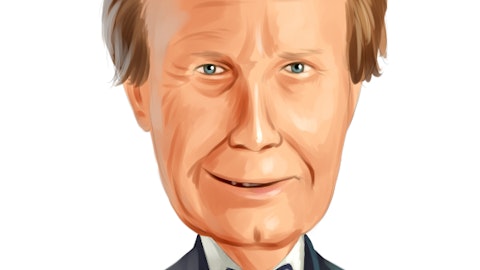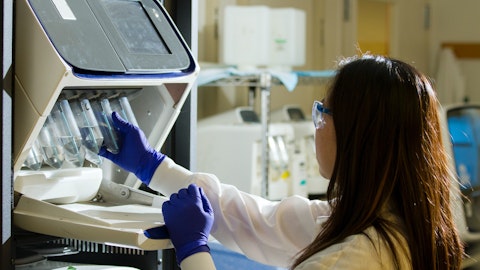Haemonetics Corporation (NYSE:HAE) Q3 2023 Earnings Call Transcript February 7, 2023
Operator: Good day, and welcome to the Haemonetics Third Quarter Fiscal ’23 Conference Call and Webcast. At this time, all participants are in a listen-only mode. After the speakers’ presentation, there will be a question-and-answer session, instructions will be given at that time. As a reminder, this call is being recorded. I would now like to turn the call over to David Trenk, Manager, Investor Relations. You may begin.
David Trenk: Good morning, everyone. Thank you for joining us for Haemonetics third quarter fiscal ’23 conference call and webcast. I’m joined today by Chris Simon, our CEO; Roy Galvin, President of our Global Plasma and Blood Center businesses; and James D’Arecca, our CFO. This morning, we posted our third quarter and year-to-date fiscal ’23 results to our Investor Relations website, along with updates to our fiscal ’23 guidance and the analytical tables with the information that we will refer to on this call. Unless otherwise noted, all revenue growth rates we will discuss today are organic and exclude the impact of currency fluctuation, strategic exits of product lines, acquisitions and divestitures. Additionally, to help investors understand Haemonetics ongoing business performance, we will refer to non-GAAP financial measures.
These measures excluded certain charges and income items. For additional details about excluded items, comparisons with the same periods in fiscal ’22 and reconciliations to our GAAP results, please refer to our third quarter and year-to-date fiscal ’23 earnings release posted on our IR website. Our remarks today will also include forward-looking statements, and our actual results may differ materially from the anticipated results. Please refer to the safe harbor statement in the earnings release and other filings with the SEC for a complete list of risk factors that may impact our results. Additionally, in order to protect customer confidentiality, we will not be able to discuss any customer-specific details except as disclosed previously.
And now I’d like to turn it over to Chris.
Chris Simon: Thanks, David. Good morning, and thank you all for joining. Today, we reported third quarter organic revenue growth of 21% and adjusted earnings per diluted share of $0.85, 1% growth over a record third quarter last year. Our third quarter results show that our long-range plan is driving continued strong performance. With growth in revenue across all of our business units despite the macroeconomic environment, we continue to build significant momentum. We’re harnessing this momentum to invest further in our plan and create additional opportunities to accelerate transformational growth. In Plasma, our value proposition is unrivaled, enabling us to support the industry’s record recovery by helping customers win donors and increase productivity to grow collections.
Recently, we amended our non-exclusive supply agreement with CSL for the use of PCS2 devices and disposable kits to extend the term from December 2023 to December 2025. We look forward to continuing to provide CSL and all of our plasma customers with the highest level of service and support. In Hospital, we remain focused on growing our market share, both in the U.S. and internationally by advancing our technology and seeking targeted acquisitions to improve standards of care. In Blood Center, we are capitalizing on opportunities created by our agility and resilience to win with customers and extend our leadership in the new markets. We are pleased with our performance and the steps we have taken to accelerate revenue and adjusted EPS growth.
We are not immune to the macroeconomic challenges of foreign exchange, inflation, supply discontinuities and geopolitical risk. However, heightened demand for our products continues unabated. The essential nature of our solutions and the durability of our businesses even during uncertain times have us well positioned for sustained growth and market leadership. We have demonstrated perseverance and the ability of our global manufacturing and supply chain to fulfill our customers’ needs uninterrupted. With increasing capital capacity and a robust allocation strategy, we are confident we can continue to deliver best-in-class solutions to our customers and attractive returns to our shareholders. We look forward to a strong fiscal ’23 finish and carrying that momentum into fiscal ’24.
Now on to our business results and guidance. I will begin with total revenue and hospital, and Roy will discuss Global Plasma and Blood Center. Corporate revenue grew 21% in the quarter and 22% year-to-date due to accelerating growth in both Hospital and Plasma. We now expect fiscal ’23 organic revenue growth in the range of 18% to 20% compared with 15% to 18% previously. Hospital revenue grew 14% in the quarter and 17% year-to-date as we meaningfully grew revenue and market share despite hospital staffing shortages, budgetary constraints and COVID-related challenges in China. Hemostasis management revenue grew 7% in the quarter and 8% year-to-date. Growth in North America, our largest market, was 16% in the quarter and 13% year-to-date, driven by strong adoption and utilization of TEG disposables.
International growth was partially offset by a difficult year-on-year comp due to a large national European tender for ClotPro in fiscal ’22 and the effect of COVID in China. Vascular Closure revenue grew 33% in the quarter and 37% year-to-date. The adverse seasonality and procedure volumes that we experienced in our second quarter persisted, but we saw encouraging improvement in December and into our fourth quarter. Our growth is disproportionately being driven by converting new electrophysiology accounts from the top 600 hospitals, further increasing our U.S. penetration and market share. We are excited about CE Mark certification for VASCADE. As we move forward with commercialization in Europe, we plan to use a direct sales model and leverage our existing back-office infrastructure.
This is one of many investments we are making to solidify our leadership position in Vascular Closure and accelerate revenue growth. Transfusion Management revenue grew 13% in the quarter and 23% year-to-date. Growth was driven by new software implementations in the U.S. and U.K. and our previous investments to expand the sales force. Lastly, Cell Salvage revenue grew 1% in the quarter and 2% year-to-date, benefiting from favorable order timing among EMEA distributors and strong capital sales, partially offset by weakness in China. In November, we received FDA approval for our Cell Saver Elite Plus featuring new intelligent control software to enhance simplicity and efficiency. It is another example of the investments we are making to solidify our market leadership and we anticipate full market release in the U.S. before fiscal year-end.
We are enthusiastic about opportunities in our hospital business and the strong value of our products. We’ve done a lot of work to transform this business into a growth engine and feel very confident about the continued momentum. We update our expectation for hospital organic revenue growth to be approximately 19% in fiscal ’23, the lower end of our previously issued guidance range of 19% to 22% due primarily to COVID-related challenges in China. Now over to you, Roy.
Roy Galvin: Thank you, Chris. Good morning, everyone. This is my first time speaking with you since I joined Haemonetics at the start of our third quarter, and I’m very pleased to be here to talk about our Plasma and Blood Center result. It’s been a great quarter for both businesses. In Plasma, revenue increased 42% in the third quarter and 48% year-to-date. North America disposals represented 85% of our plasma revenue and increased 46% in the quarter and 52% year-to-date, driven by strong growth in collection volume and price as a result of the technology upgrades. Volume growth was pronounced across all geographies. In the U.S., plasma collections grew 26% in the quarter and 34% year-to-date, excluding CSL. In Europe, collections grew in the mid-teens in the quarter and year-to-date.
Both geographies have surpassed pre-pandemic collection levels and are going to meet patient demand. We remain focused on providing our customers with the tools necessary to support continued recovery in attracting and retain their donors. Our Persona technology represents over half of the Nexus collections in the U.S. today and is an enabler of plasma volume growth and improved central efficiency. Since the commercial launch of this technology, more than 12 million Persona procedures have been completed. The real-world data collected has reinforced the safety profile establishing the original impact plasmapheresis clinical trial when combined with our NexLynk DMS software and other digital tools, plasma centers also experienced shorter door-to-door times and an overall more favorable donation experience.

Romaset/Shutterstock.com
The substantial cost per liter improvement available to our integrated Nexus platform is unrivaled within the industry, and we are just getting started. Encouraged by the strength of our business and the opportunity to continue to support CSL as a result of the newly amended agreement, we are raising our fiscal ’23 organic Plasma revenue guidance to 35% to 40% growth, up from the 30% to 35% growth we communicated last quarter. In Blood Center, revenue grew 3% in the quarter and declined 1% year-to-date. The environment for this business continues to be challenging. However, we remain focused on providing top quality products at the highest level of customer support while utilizing the strength of our supply chain and our technology to increase our market share.
Apheresis revenue declined 3% in the quarter and 6% year-to-date. This business was affected by unfavorable order timing, lower revenue from convalescent plasma, staffing and donor shortages at blood centers across the globe and COVID-related challenges in China. Partially offsetting these was an increase in capital sales from our Egyptian plasma effort undertaking partnership with a global plasma customer. Our blood revenue increased 2% quarter and 11% year-to-date. Growth in this product line, both in the quarter and year-to-date was driven by our hard supply chain that’s enabled us to serve customers in need and favorable order timing in EMEA and Asia Pacific. Before I discuss updated Blood Center guidance, I would like to remind everyone that earlier in the pandemic, we benefited from increased levels of safety stock across many of our customers.
What we observed in the third quarter is the beginning of inventory rationalization, which we believe will continue into the fourth quarter and potentially beyond. We are confident in the continued durability of our Blood Center business and update our expectations of revenue declined to negative 2% to 4% in fiscal ’23 compared with a negative 2% to 5% previously. Our guidance reflects strong year-to-date results and the anticipated impact of inventory rationalization. Now over to James to discuss the rest of the financial results and guidance.
James D’Arecca: Thank you, Roy, and good morning, everyone. As you heard from Chris and Roy, all of our businesses are performing exceptionally well. The demand for our products is strong, and we are doing everything we can to ensure uninterrupted supply and best-in-class service to our customers. In order to ensure continued success in fiscal ’24, we are proactively making changes to our manufacturing and supply network. This includes increasing our production capacity for plasma disposables and securing additional vendor contracts. Most initiatives are underway, resulting in an additional impact on operational efficiencies in the second half of our fiscal ’23, which I will discuss in more detail momentarily. Moving on to gross margins.
The third quarter adjusted gross margin was 52.5%, a decrease of 240 basis points compared to last year when we reported one of our highest ever adjusted gross margins of 54.9%. We continue to experience strong volume growth and realize benefits from price and our operational excellence program. Offsetting these benefits was a 70 basis point onetime inventory charge due to the effects of COVID in China, additional inflationary pressures, including operational inefficiencies as we work to increase our production capacity and higher depreciation expense. Adjusted gross margin year-to-date was 53.7%, a decrease of 40 basis points compared with the first nine months of the prior year. The primary drivers include strong growth in volume, benefits from price, mix and our operational excellence program, offset by higher manufacturing and supply chain costs and depreciation expense.
Adjusted operating expenses in the third quarter were $101.4 million, an increase of $17.6 million or 21% compared with the prior year. As a percentage of revenue, adjusted operating expenses increased by 90 basis points to 33.2%. Adjusted operating expenses year-to-date were $299.9 million, an increase of $46.7 million or 18% compared with the prior year. As a percentage of revenue, adjusted operating expenses year-to-date decreased by 10 basis points to 34.7%. Higher adjusted operating expenses in both periods were driven by higher performance-based compensation, continuous investments in sales and marketing, higher freight costs and normalized spending levels, partially offset by additional savings from the operational excellence program.
In our third quarter, we also had higher research and development costs, primarily driven by increased investments in product innovation. Adjusted operating income was $59 million in the third quarter and $164.5 million year-to-date, representing increases of $0.2 million and $24 million, respectively. As a percentage of revenue, adjusted operating margin was 19.3% in the third quarter and 19% year-to-date, down 330 basis points and 30 basis points, respectively, when compared with the same period in fiscal ’22. We reaffirm our adjusted operating margin guidance in the range of 18% to 19%. Our adjusted operating margin guidance includes higher performance-based compensation, approximately 380 basis points of impact from macroeconomic headwinds and increased operational inefficiencies, partially offset by $26 million in target fiscal year ’23 gross savings from the operational excellence program.
The adjusted income tax rate was 25% in the third quarter and 24% year-to-date, compared with 21% and 22% in the same period in fiscal ’22. The higher income tax rate in our third quarter was related to changes in jurisdictional earnings as well as a onetime catch-up related to executive stock compensation. We expect our fiscal ’23 adjusted income tax rate to be approximately 24%. Third quarter adjusted net income was $43.6 million, up approximately $1 million or 2%, and adjusted earnings per diluted share was $0.85, up 2% when compared to the third quarter of fiscal ’22. Year-to-date adjusted net income was $116.5 million, up $17 million or 18% and adjusted earnings per diluted share was $2.26, up 17% when compared with the first nine months of fiscal ’22.
The combination of the adjusted income tax rate, interest expense and FX had a negative $0.02 a $0.12 impact on adjusted earnings per diluted share in the third quarter and year-to-date, respectively, when compared with fiscal ’22. We are updating our fiscal ’23 adjusted earnings per diluted share guidance to be in the range of $2.90 to $3 compared with the previous guidance of $2.70 to $3 The midpoint of our adjusted earnings per diluted share guidance includes an approximate $0.16 headwind from volatility in foreign exchange, adjusted income tax and slightly higher interest expense. Now let’s discuss our balance sheet and cash flow. Cash on hand at the end of the third quarter was $224 million, down $36 million since the beginning of the fiscal year, primarily due to the $75 million accelerated share repurchase program, $35 million in earnout payments related to previous acquisitions and a €30 million investment in Vivasure Medical, partially offset by higher net income.
Free cash flow before restructuring and restructuring-related costs was $119 million compared with $75.8 million in the first nine months of the prior year. The higher free cash flow before restructuring and restructuring-related costs was mainly due to a higher cash flow from operating activities. These include significantly higher net income, lower inventory, primarily due to the Nexus conversions in the U.S. and higher accrued liabilities, including higher performance-based compensation, excluding capital placements, inventory increased year-over-year We believe in our ability to generate strong cash flow and update our guidance for free cash flow before restructuring and restructuring related costs for fiscal ’23 to be in the range of $160 million to $180 million compared with $150 million to $180 million previously.
The updated guidance reflects higher net income and fiscal benefits from net working capital in fiscal ’23. Before I turn the call back to the operator, I’d like to summarize a few key takeaways from today’s call. In our Plasma business, we are experiencing unprecedented growth in collection volume across all of our customers, disproportionately contributing to the anticipated 35% to 40% revenue growth in our fiscal ’23. Our technology is enabling substantial cost per liter improvement, and we are making meaningful progress with our innovation agenda. Hospital growth is propelled by revenue growth in hemostasis management and vascular closure, strengthening our market leadership and improving our adjusted gross margins. This business continues to prove itself as a growth engine, and we look forward to continued momentum in fiscal ’24.
The margin expansion goals we presented in our long-range plan are on track despite the additional near-term operational inefficiencies. The operational excellence program continues to drive meaningful benefits for our company from mitigating the effects of macroeconomic headwinds to helping effectively meet customer demand for our products. And finally, the strength of our underlying business, coupled with steps we’ve taken over the past few months will enable consistent expansion of our capital capacity. With the capital allocation priorities being unchanged, we will be disciplined with allocating capital to high-impact, high ROI project that accelerate growth and value creation. Thank you for your time today. And operator, you may now begin the Q&A.
See also 10 Most Undervalued Utility Stocks to Buy and 15 Most Undervalued Value Stocks To Buy.
Q&A Session
Follow Haemonetics Corp (NYSE:HAE)
Follow Haemonetics Corp (NYSE:HAE)
Q – Drew Ranieri: Hi, good morning. Thanks for taking the questions. Chris, maybe kind of a first multipart question. But just kind of given the current environment right now and your recent commentary at a conference, and you sounded very confident in growth in every year of your LRP, and including next one. Just how should we think about that, especially in the context with the amended CSL agreement and how you’re thinking about that influencing the near-term plan? And then just on CSL, maybe just – I know you don’t want to get into the specifics on revenue. But for whatever assumptions investors want to make on the revenue impact for ’23, ’24 or ’25. Can you just maybe talk about the potential flow through to EPS? I mean at Analyst Day, you gave a slide that gave us some incremental detail there for fiscal 2022. But just maybe walk us through the puts and takes if anything has kind of changed on that end, sorry for the multipart there.
Chris Simon: Thanks, Drew. Appreciate you dialing in. In terms of the macro environment and our degree of confidence, it remains quite high, right? There are external challenges for sure. But I think as an organization, we benefit as much in this environment as we are challenged. We look at the durability of our Blood Center business. We look at the essential nature of what we do in a hospital, whether it’s cardiovascular, interventional cardiology, trauma transplant, right? These are all high demand issues. So if hospitals are staff and functioning, we’re going to continue to perform as we have. And then Plasma has done very well in good markets and in bad alike, and there’s clearly strong forces at work that are helping what our customers are leaning heavily into, which is to drive increased plasma collections.
So there are challenges on the cost side. James highlighted a bunch of those, and we’re happy to talk through those. But from a macro perspective, there’s real uptick in demand, and we don’t see that abating across any of our three businesses anytime soon. In terms of the CSL agreement, I know there’s a ton of curiosity around that. And I appreciate that you can understand that the terms of the agreement are strictly confidential. What I would say at the macro level, again, is this is good for patients. It’s good for donors, it’s good for customers and it’s good for shareholders. Our view from this from the outset has been that we are playing the long game, and we will continue to invest and deliver accordingly. Anything that gets pulled forward from the CSL agreement will be additive to our prior commitments around growth in each year of the LRP and the overall margin expansion that we’ve outlined.
Drew Ranieri: Got it. Thanks. And then just maybe a near-term question, but with a biotech companies readout potentially in the second quarter, how are you kind of thinking about that as a potential structural impact for plasma over the longer term? Thanks for taking the questions.
Chris Simon: Yes. Thanks, Drew. We look at that near and long term. We’ve done a bunch of modeling. We don’t profess to have any proprietary insight beyond what we hear from key opinion leaders and what we know from other algorithms of competitive entries in the biologics space. Candidly, from a patient service perspective, we hope that anti-FcRn has a role to play going forward, particularly in therapeutic areas where IG may not be the most efficacious treatment. From what we have seen and the most recent communications, we stand firm around our original assumptions, which is we’ve always talked about the long-term growth in demand for IG somewhere in that 6% to 8% range. And you can shave a point off of that, I guess, in either direction, depending on the relative success of the FcRn players.
But from our vantage point, we feel quite good about that base assumption. We’re going to watch carefully to see the next milestone readouts and talk closely with all of our customers about their view on this. But 6% to 8% demand for IG converts nicely to 8% to 10% demand in collection volumes, probably closer to 10% to 12% organic growth, just given changes in the nature of subcutaneous for example, requires more IG for the same dose equivalency. So we’ll see this revert eventually to that long-term mean of 8% to 10% with a bit higher in our business because of mix and some of the other things that we have going on. But there’s nothing we’ve heard or seen that would back us off of that long-range forecast.
Drew Ranieri: Okay. Thanks for taking the questions.
Operator: Thank you. Our next question comes from Mike Matson with Needham & Company. Your line is open.
Mike Matson: Yeah, good morning. Thanks for taking my questions. So I want to ask one on the gross margins. We’ve seen some really strong growth from the overall company from the Plasma business here. And you – but yet your gross margins have been down. And I understand there is some one-off factors, but inflation and things like that. But I guess, is there just a mix effect happening with the Plasma gross margins being lower, that’s where you’re seeing the strongest growth? Or I guess why is it – I would have guessed you would have seen more leverage, just given the – how fast that plasma business is growing?
James D’Arecca: Hi, Mike, it’s James. Thanks for the question. Yes, on gross margin, it actually is – the mix element has been favorable to us, along with our OEP savings. But what’s taken us in the opposite direction and offset those benefits is really a few things, which we’ve kind of highlighted. One is the additional depreciation from our Nexus systems. And then the other one, which is the bigger part is the manufacturing headwinds on inflation that you just referenced. But also, as I noted in my remarks, we’ve been experiencing, I would say, larger than usual operational inefficiencies due to the strong growth. That’s put us in a position to have to buy components and other manufacturing inputs at spot prices. So things like sterilization or hard-to-find parts, which in the past used at the order in advance.
Now when you have to go into the spot market, it raises the prices and it’s having an effect on our margin. Longer term, however, we see that part of it that – I’ll call the temporary inefficiency part of it abating as we – as our production plans become more – more crystallized. So we do see, over the longer term, the one effect that you just said, mix, really helping us volume helping us and then by removing those inefficiencies that I just spoke about, that’s what will push our gross margins much higher as we get out into our LRP.





